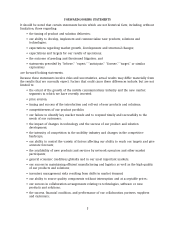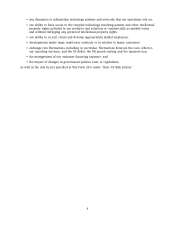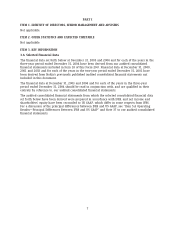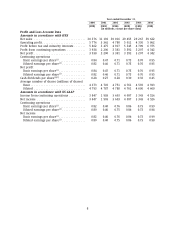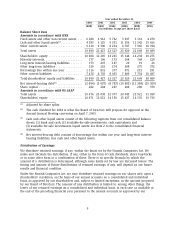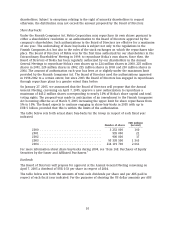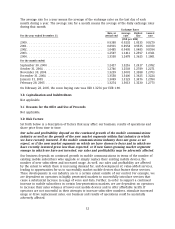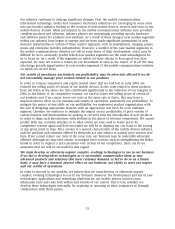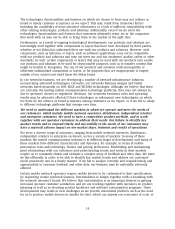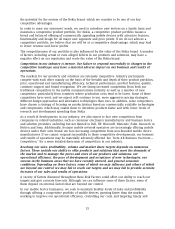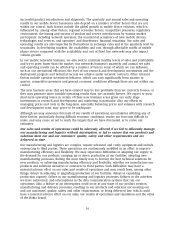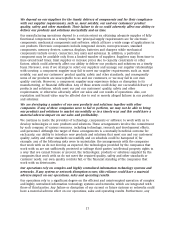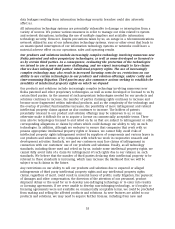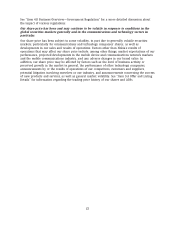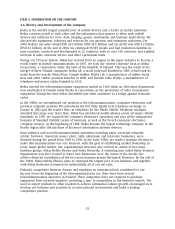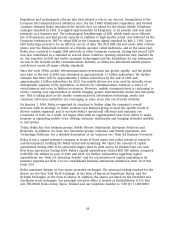Nokia 2004 Annual Report Download - page 16
Download and view the complete annual report
Please find page 16 of the 2004 Nokia annual report below. You can navigate through the pages in the report by either clicking on the pages listed below, or by using the keyword search tool below to find specific information within the annual report.the potential for the erosion of the Nokia brand, which we consider to be one of our key
competitive advantages.
In order to meet our customers’ needs, we need to introduce new devices on a timely basis and
maintain a competitive product portfolio. For Nokia, a competitive product portfolio means a
broad and balanced offering of commercially appealing mobile devices with attractive features,
functionality and design for all major user segments and price points. If we do not achieve a
competitive portfolio, we believe that we will be at a competitive disadvantage, which may lead
to lower revenue and lower profits.
The competitiveness of our portfolio is also influenced by the value of the Nokia brand. A number
of factors, including actual or even alleged defects in our products and solutions, may have a
negative effect on our reputation and erode the value of the Nokia brand.
Competition in our industry is intense. Our failure to respond successfully to changes in the
competitive landscape may have a material adverse impact on our business and results of
operations.
The markets for our products and solutions are intensely competitive. Industry participants
compete with each other mainly on the basis of the breadth and depth of their product portfolios,
price, operational and manufacturing efficiency, technical performance, product features, quality,
customer support and brand recognition. We are facing increased competition from both our
traditional competitors in the mobile communications industry as well as a number of new
competitors, particularly from countries where production costs tend to be lower. Some of these
competitors have used, and we expect will continue to use, more aggressive pricing strategies,
different design approaches and alternative technologies than ours. In addition, some competitors
have chosen a strategy of focusing on productization based on commercially available technologies
and components, which may enable them to introduce products faster and with lower levels of
research and development spending than Nokia.
As a result of developments in our industry, we also expect to face new competition from
companies in related industries, such as consumer electronics manufacturers and business device
and solution providers, including but not limited to Dell, HP, Microsoft, Nintendo, Palm, Research in
Motion and Sony. Additionally, because mobile network operators are increasingly offering mobile
devices under their own brand, we face increasing competition from non-branded mobile device
manufacturers. If we cannot respond successfully to these competitive developments, our business
and results of operations may be materially adversely affected. See ‘‘Item 4.B Business Overview—
Competition,’’ for a more detailed discussion of competition in our industry.
Reaching our sales, profitability, volume and market share targets depends on numerous
factors. These include our ability to offer products and solutions that meet the demands of
the market and to manage the prices and costs of our products and solutions, our
operational efficiency, the pace of development and acceptance of new technologies, our
success in the business areas that we have recently entered, and general economic
conditions. Depending on those factors, some of which we may influence and others of which
are beyond our control, we may fail to reach our targets and we may fail to provide accurate
forecasts of our sales and results of operations
.
A variety of factors discussed throughout these Risk Factors could affect our ability to reach our
targets and give accurate forecasts. Although, we can influence some of these factors, some of
them depend on external factors that are beyond our control.
In our mobile device businesses, we seek to maintain healthy levels of sales and profitability
through offering a competitive portfolio of mobile devices, growing faster than the market,
working to improve our operational efficiency, controlling our costs, and targeting timely and
15


